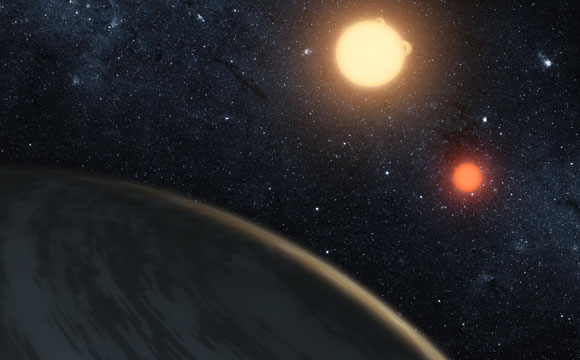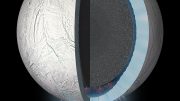
This artist’s concept illustrates Kepler-16b, the first planet known to definitively orbit two stars – what’s called a circumbinary planet. The planet, which can be seen in the foreground, was discovered by NASA’s Kepler mission. Credit: NASA/JPL-Caltech/T. Pyle
Newly published research from astronomers at Cornell University suggests that there may be a new population of circumbinary planets, which orbit around more-compact binaries (with periods less than a few days) and have their orbital axes misaligned with the binary axes.
Sibling suns – made famous in the “Star Wars” scene where Luke Skywalker gazes toward a double sunset – and the planets around them may be more common than we’ve thought, and Cornell astronomers are presenting new ideas on how to find them.
Astronomers could discover a plethora of planets around binary star systems (stars that rotate around each other) by measuring with high precision how stars move around each other, looking for disturbances exerted by possible exoplanets. So explains new research, “Survival of Planets Around Shrinking Stellar Binaries,” published in the Proceedings of the National Academy Sciences, July 9, by Diego J. Munoz, Cornell postdoctoral researcher, and Dong Lai, professor of astronomy, in the College of Arts and Sciences.
What once was fictional as young Skywalker saw the double suns from Tatooine is astronomical reality four decades later. Normal binary suns orbit each other every eight to 100 days, and the Kepler telescope easily can detect those exoplanets (planets outside of our own solar system) as the planets transit (move across) each sun.
Trouble starts in compact binary sun systems – where sibling suns move closer together – making it difficult for the most advanced telescopes to find them. Essentially, for Kepler and other telescopes, the planetary orbital plane of these double suns and their accompanying planets might be out of whack – or misaligned – rendering them invisible to us. “The current observational strategy inevitably misses a population of Tatooine planets, but future observations may reveal their existence,” said Munoz.
NASA video describes the Kepler satellite’s first discovery of a planet orbiting sibling suns in 2011. With the publication of this Cornell research, astronomers may be able to find planets within compact binary systems.
NASA’s Kepler telescope is a heliocentric (it orbits the sun) spacecraft that monitors star brightness in a Milky Way region near the constellation Cygnus, the swan. Measuring photons, Kepler detects lower light values – and thus, a planetary transit.
Munoz explains that suns in the close binary system likely were once standard systems that have lost energy and shrunk, bringing the suns closer together. As the sibling sun’s distance decreases, the orbits of that system’s planets become misaligned, rendering it impossible for the Kepler telescope to detect planets – which no longer cross in the front of the suns.
Munoz and Lai suggest scouting for exoplanet-caused disturbances for compact binary star systems, to determine a new population of circumbinary planets. Said Munoz: “Since this type of ‘compact’ binary is very common, it had been very puzzling that no planets had been detected.”
This research was funded by the National Science Foundation and by NASA.
Reference: “Survival of planets around shrinking stellar binaries” by Diego J. Muñoz and Dong Lai, 9 July 2015, PNAS.
DOI: 10.1073/pnas.1505671112









How does a circumbinary planet maintain a stable orbit around its parent stars? It seems that the gravitational tug from the stars would be constantly varying from relatively strong when the planet is most nearly inline with the stars to relatively weak when the alignment of bodies is least linear. I would expect eventually that the planet would be either ejected by the parents or consumed by them. How is equilibrium maintained?